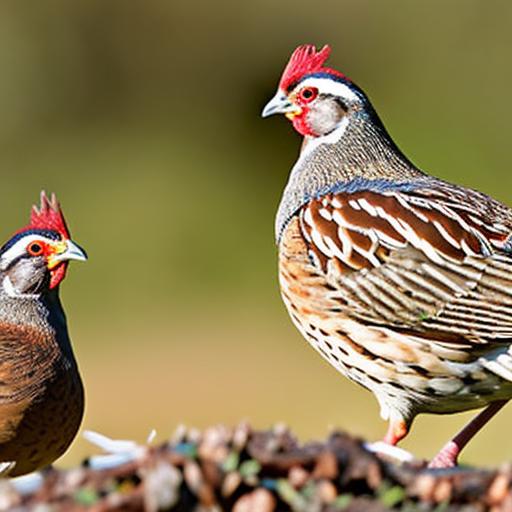Keeping quail and chickens together in a chicken coop is a practice that has gained popularity among backyard poultry enthusiasts. This practice offers several benefits, such as increased egg production and pest control. However, there are also potential risks involved, such as disease transmission and aggression between the two species. Before deciding to integrate quail and chickens in a coop, it is important to understand the differences between these birds and take necessary precautions to ensure their cohabitation is successful.
Key Takeaways
- Quail and chickens have different needs and behaviors, but can be kept together with proper planning and care.
- Benefits of keeping quail and chickens together include increased egg production and pest control.
- Potential risks of keeping quail and chickens together include disease transmission and aggression.
- Preparing a chicken coop for quail involves adding appropriate bedding, nesting boxes, and perches.
- Feeding quail and chickens together requires providing a balanced diet and separate feeding areas.
Understanding the Differences between Quail and Chickens
Quail and chickens have distinct physical and behavioral differences that can affect their cohabitation in a chicken coop. Quail are smaller in size compared to chickens, with a more compact body shape. They have shorter legs and wings, which allow them to fly short distances. Chickens, on the other hand, are larger and heavier birds with longer legs and wings that are not designed for sustained flight.
In terms of behavior, quail are known to be more skittish and flighty compared to chickens. They tend to be more independent and prefer to forage on the ground rather than roosting in trees or perches like chickens. Chickens, on the other hand, are social animals that prefer to stay together in a flock. They are also more territorial and can exhibit aggressive behavior towards other birds.
These differences in size, behavior, and habitat preferences can affect their cohabitation in a chicken coop. It is important to provide adequate space and resources to accommodate both species’ needs.
Benefits of Keeping Quail and Chickens Together
Keeping quail and chickens together in a chicken coop can offer several benefits. One of the main benefits is increased egg production. Quail are prolific layers, capable of producing up to 300 eggs per year. By integrating quail into a chicken coop, you can significantly increase your egg production without needing additional space or resources.
Another benefit is pest control. Quail are excellent foragers and can help control pests such as insects and slugs in the coop and surrounding areas. They have a keen eye for spotting small insects and can quickly eliminate them from the environment.
Additionally, quail and chickens can have a symbiotic relationship. Quail can benefit from the protection provided by the larger chickens, while chickens can benefit from the smaller quail’s ability to find and eliminate pests. This mutualistic relationship can create a healthier and more balanced ecosystem within the coop.
There are many successful examples of cohabitation between quail and chickens. Many backyard poultry enthusiasts have reported positive experiences with integrating these two species in a coop. With proper planning and management, it is possible to create a harmonious environment where both quail and chickens can thrive.
Potential Risks of Keeping Quail and Chickens Together
While there are benefits to keeping quail and chickens together, there are also potential risks that need to be considered. One of the main risks is disease transmission. Quail and chickens can carry different diseases that may not affect one species but can be harmful to the other. It is important to monitor the health of both species regularly and take necessary precautions to prevent the spread of diseases.
Another risk is aggression between the two species. Chickens can be territorial and may exhibit aggressive behavior towards quail, especially during feeding or when establishing a pecking order. This aggression can lead to injuries or stress for the quail. It is important to provide enough space and resources to minimize aggression and ensure the well-being of both species.
To minimize these risks, it is important to quarantine new birds before introducing them to an existing flock. This allows for observation and testing for any potential diseases before exposing them to other birds. It is also important to provide separate feeding areas for quail and chickens to prevent feed aggression.
Preparing Your Chicken Coop for Quail
Before introducing quail to a chicken coop, there are several necessary preparations that need to be made. One important consideration is the addition of nesting boxes. Quail prefer to lay their eggs in secluded areas, so providing nesting boxes with low entrances can help accommodate their needs.
Another consideration is the addition of perches. While chickens are known to roost on perches, quail prefer to stay on the ground. However, providing low perches or platforms can give quail a place to rest and feel secure.
It is also important to ensure that the coop is secure and predator-proof. Quail are smaller and more vulnerable to predators compared to chickens. Adding wire mesh or hardware cloth to the coop can help prevent predators from gaining access.
Additionally, providing adequate ventilation and lighting in the coop is important for the health and well-being of both quail and chickens. Good ventilation helps prevent the buildup of ammonia and moisture, which can lead to respiratory issues. Sufficient lighting helps regulate their internal clocks and promotes healthy egg production.
Designing a Chicken Coop Plan for Quail and Chickens

When designing a chicken coop plan that can accommodate both quail and chickens, there are several factors to consider. One important factor is space. Both quail and chickens require adequate space to move around and exhibit their natural behaviors. Providing enough square footage per bird is crucial for their well-being.
Another factor is the layout of the coop. It is important to provide separate areas for quail and chickens, especially during feeding time. This can help minimize aggression and ensure that all birds have access to food and water.
Additionally, providing different levels or platforms within the coop can help accommodate the different needs of quail and chickens. Quail prefer to stay on the ground, while chickens may prefer to roost on perches or platforms.
There are many successful coop designs that can accommodate both quail and chickens. Some designs include separate sections or compartments for each species, while others have open spaces with designated areas for different activities. It is important to choose a design that suits your specific needs and the number of birds you plan to keep.
Choosing the Right Size of Chicken Coop for Quail and Chickens
Choosing the right size of a chicken coop is crucial for the well-being of both quail and chickens. The size of the coop will depend on the number of birds you plan to keep and their specific needs.
A general rule of thumb is to provide at least 2-3 square feet of floor space per quail and 4-5 square feet per chicken. This allows for adequate space for movement and reduces the risk of aggression.
To calculate the minimum square footage needed, you can use the following formula:
(Number of quail x 2) + (Number of chickens x 4) = Minimum square footage needed
It is important to note that this formula provides a minimum requirement and it is always better to provide more space if possible.
Feeding Quail and Chickens Together in a Chicken Coop
Feeding quail and chickens together in a chicken coop can be challenging, as they have different dietary requirements. Quail require a higher protein diet compared to chickens, especially during their egg-laying period. It is important to provide a balanced feed that meets the nutritional needs of both species.
One option is to provide a commercial feed that is specifically formulated for both quail and chickens. These feeds are designed to meet the nutritional requirements of both species and can simplify feeding management.
Another option is to provide separate feeding areas for quail and chickens. This can help prevent feed aggression and ensure that all birds are getting enough food. It is important to monitor the feeding behavior of both species and make adjustments as needed.
Additionally, providing access to fresh water at all times is crucial for the health and well-being of both quail and chickens. Water should be clean and free from contaminants to prevent the spread of diseases.
Maintaining a Clean and Healthy Chicken Coop for Quail and Chickens
Maintaining a clean and healthy chicken coop is essential for the well-being of both quail and chickens. Regular cleaning helps prevent the buildup of waste, parasites, and diseases.
One important aspect of coop maintenance is regular cleaning of bedding material. Bedding should be replaced regularly to prevent the buildup of ammonia and moisture, which can lead to respiratory issues. It is important to choose bedding material that is safe for both quail and chickens, such as straw or wood shavings.
Another aspect is regular cleaning of feeders and waterers. These should be cleaned and sanitized regularly to prevent the spread of diseases. It is also important to provide fresh bedding material in nesting boxes to ensure a clean and comfortable environment for egg-laying.
Additionally, regular inspection for signs of pests or parasites is important. Common pests such as mites or lice can affect both quail and chickens. If any signs of infestation are detected, appropriate measures should be taken to eliminate the pests.
Factors to Consider Before Keeping Quail and Chickens Together in a Chicken Coop
Keeping quail and chickens together in a chicken coop can offer several benefits, such as increased egg production and pest control. However, there are also potential risks involved, such as disease transmission and aggression between the two species.
Before deciding to integrate quail and chickens in a coop, it is important to consider several factors. These include understanding the differences between quail and chickens, preparing the coop for quail, designing a coop plan that accommodates both species, choosing the right size of the coop, feeding them together, and maintaining a clean and healthy environment.
It is crucial to do thorough research, consult with experts, and consider your specific circumstances before making a decision. By taking necessary precautions and providing adequate space and resources, it is possible to create a harmonious environment where both quail and chickens can thrive.
If you’re considering keeping quail and chickens together, it’s important to understand the dynamics between these two types of birds. While they can coexist in the same space, there are certain factors to consider. To learn more about this topic, check out this informative article on Poultry Wizard titled “Can I Keep Quail and Chickens Together?” This article provides valuable insights into the compatibility of quail and chickens, discussing their housing requirements, social interactions, and potential challenges. For further guidance on poultry keeping, you may also find these related articles helpful: “How Many Chickens Do You Need for a Family of 4?” and “Can Guinea Fowl Live with Chickens?”.
FAQs
Can I keep quail and chickens together?
Yes, it is possible to keep quail and chickens together in the same coop or run.
What are the benefits of keeping quail and chickens together?
Keeping quail and chickens together can provide a variety of benefits, including increased egg production, pest control, and socialization for both species.
What are the potential drawbacks of keeping quail and chickens together?
The main potential drawback of keeping quail and chickens together is the risk of disease transmission between the two species. Additionally, quail may be more susceptible to bullying or aggression from larger chickens.
What should I consider before keeping quail and chickens together?
Before keeping quail and chickens together, it is important to consider the size of your coop or run, the number of birds you plan to keep, and the compatibility of the two species. It is also important to research and implement proper biosecurity measures to prevent disease transmission.
What steps can I take to ensure the health and safety of my quail and chickens?
To ensure the health and safety of your quail and chickens, it is important to provide adequate space, food, and water for both species. Additionally, you should regularly clean and disinfect your coop or run, and quarantine any new birds before introducing them to the flock. Finally, it is important to monitor your birds for signs of illness and seek veterinary care if necessary.
Meet Walter, the feathered-friend fanatic of Florida! Nestled in the sunshine state, Walter struts through life with his feathered companions, clucking his way to happiness. With a coop that’s fancier than a five-star hotel, he’s the Don Juan of the chicken world. When he’s not teaching his hens to do the cha-cha, you’ll find him in a heated debate with his prized rooster, Sir Clucks-a-Lot. Walter’s poultry passion is no yolk; he’s the sunny-side-up guy you never knew you needed in your flock of friends!







